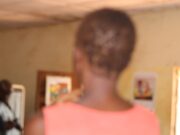Breastfeeding isn’t supposed to hurt, but the truth is that it does hurt for many new moms. Actually, most moms I know of have had episodes where their nipples hurt at some point during the early stages of nursing (myself included). So, how is one supposed to avoid that agonizing moment of having sore, cracked, painful and sometimes bleeding nipples? The hurt is especially so bad because during those first weeks, all the baby feeds on is your milk, and the thought of baby sucking from that painful nipple to get his feed can be a real killjoy. ![]()

I addressed this question to lactation consultant Josie M. Karoki of HunySuckle, who shed more light on the issue.
MT: What causes sore or cracked nipples in breastfeeding moms?
JMK: The nipples are the channels through which the breast milk is delivered, so the baby needs to have the nipple in his mouth in order to get the milk. The baby needs to latch on to most of the breast and not just onto the nipple in order for him to effectively extract milk and for it to be delivered into his mouth through the nipple. The most common reason for sore or cracked nipples is when the baby latches onto the nipple and not the breast.
Basically when the baby only attaches onto the nipple, it means that as he is suckling, his tongue and hardest part of his palate (close to the mouth) is rubbing onto mum’s nipple and this will naturally be uncomfortable and unless corrected, it can lead to soreness and cracks.
To better understand this, place your own tongue on the roof of your mouth (the palate) and feel the different sections:
i)The hardest part with ridges is closest to the front of the mouth
ii)The softer part, which is smooth, soft and slightly rounded, is towards the back of the mouth.
When a baby is properly attached to the breast, his mum’s nipple should be at the soft part of his palate (ii) and this means that there will neither be discomfort nor friction against the nipple as the baby is suckling.
It also means that most of the areola (the darkest part of the breast) will be in the baby’s mouth and his tongue will be extended outwards with his mouth completely wide open. This is known as a deep latch-on and is the most effective way for a baby to breastfeed as well as the least painful for mum.
MT: How can a mom suffering from cracked nipples relieve the pain and discomfort?
JMK: She has several options, including:
i) Applying a few drops of her own breast milk onto her nipples because breast milk is full of healing properties
ii) Applying 100% pure lanolin, which does not require to be washed off before each feed. Leading brands such as Medela, Lansinoh and Avent sell recommended nipple creams which are 100% hospital grade lanolin
iii) Air-drying your nipples which means leaving your breasts uncovered for at least 30 minutes everyday
iv) Avoid products that need to be wiped off before breastfeeding the baby because this will cause further irritation and avoid petroleum based products because these will lock in moisture and make it difficult for the wounds to heal
v) If the nipples are severely cracked it is also advisable to avoid latching the baby onto to them until they have had a chance to slightly heal because the pain a mum feels may make turn the breastfeeding experience into a negative one for both herself and baby. In this case, it is advisable to express milk, preferably by hand because this is most comfortable. Then feed the expressed breast milk to the baby using a cup. A breast pump is not advisable because it may cause further damage and pain to the nipple tissue.
However, the most effective remedy for sore or cracked nipples is a deep latch-on and for this to happen, the baby needs to be correctly positioned to the breast, his body is facing his mum’s and their tummies touching.
It will not matter how much lanolin or breast milk you apply on your nipples or how long you air them out for as long as your baby is still not latching on correctly because the nipples will not be able to heal if they are constantly experiencing the friction caused by a shallow latch-on.
It is also advisable to seek professional help as soon as any signs of nipple soreness are noticed. Support and advice is available from breastfeeding peer counselors and lactation managers such as myself.
For more information feel free to contact Josie at lactation@hunysuckle.com








































